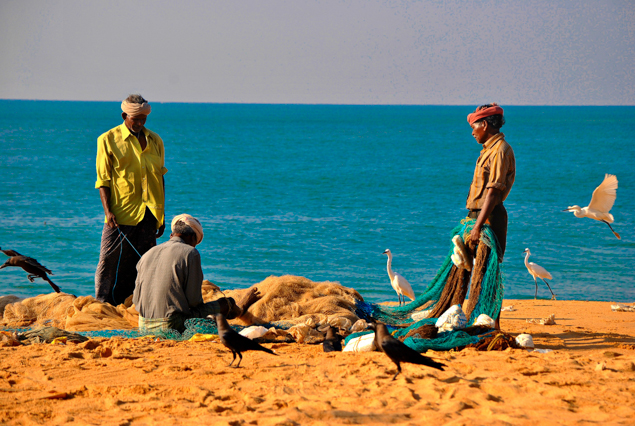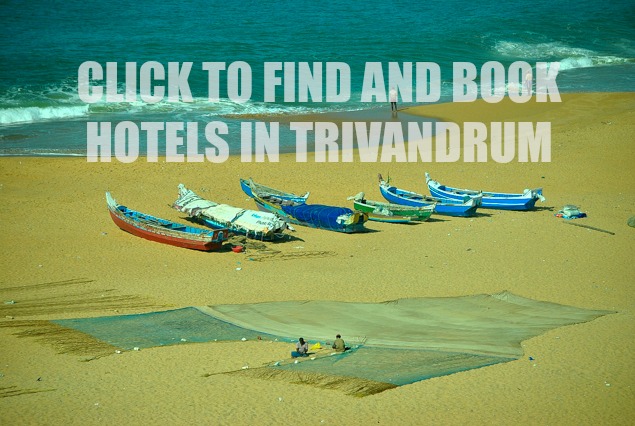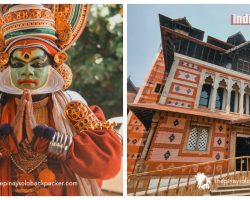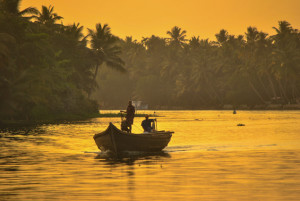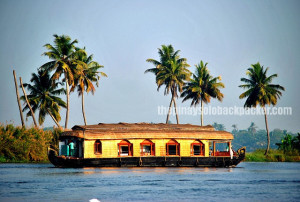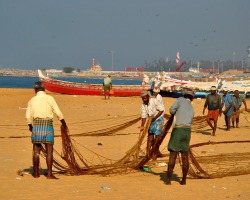Sun-spangled golden sands lapped by placid, cerulean sea cast a cheerful spell. Fishermen started chanting rhythmic Sanskrit slokas loudly that wafted across the water while they dragged a time-worn boat onto the shore. And as they started to unload their catch and clean their nets, cattle egrets started hovering above them trying to steal some fresh fish.
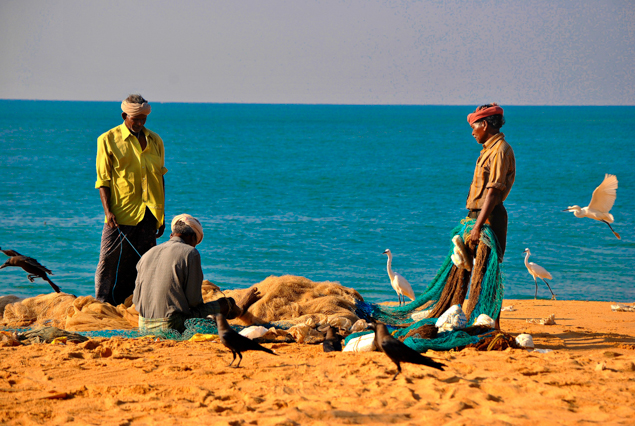
Thiruvananthapuram is framed by the Arabian Sea in the west and Tamil Nadu in the east. Seen here are local fishermen cleaning the net while cattle egrets surround them, trying to nab fish.
“Can I take a photo?”, I asked timidly as I watched them in awe. A villager, with sun-streaked hair and fine lines on his face, smiled.
I was in Thiruvananthapuram or Trivandrum – a district of Kerala in southern India – which boasts of a pleasing mosaic of interesting beaches, vast network of emerald green backwaters, historic monuments and a wealth of cultural heritage.
A Wealth of Architectural Opulence
Our exploration of this green city commenced at the celebrated place of worship known as Sree Padmanabhaswamy Temple. Trivandrum was actually baptized after Lord Anantha – the serpent deity enshrined at the Hindu temple on its eponymous capital – Thiruvananthapuram city, on which Padmanabhan or Vishnu reclines.
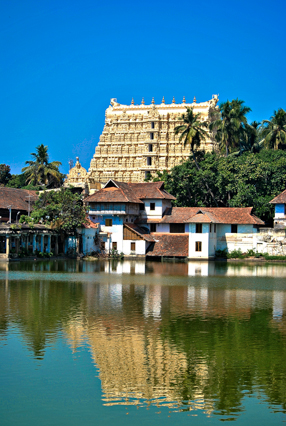
“The idol is plated in gold and made out of a rare composition known as katu-sarkara-yogam,” our well-known guide Manoj Ettan (who also toured Anthony Burdain around Kerala) revealed.
Believed to date back to the 18th century, this iconic edifice was the brainchild of King Marthanda Varma – built for the Travancore royal family. A recent inventory of the temple vaults led to the discovery of a mind-boggling sum of treasures – Napoleonic gold coins, jewelries, and statues – kept in its crypts, amounting to over USD 20 billion – making it the richest temple in the world!
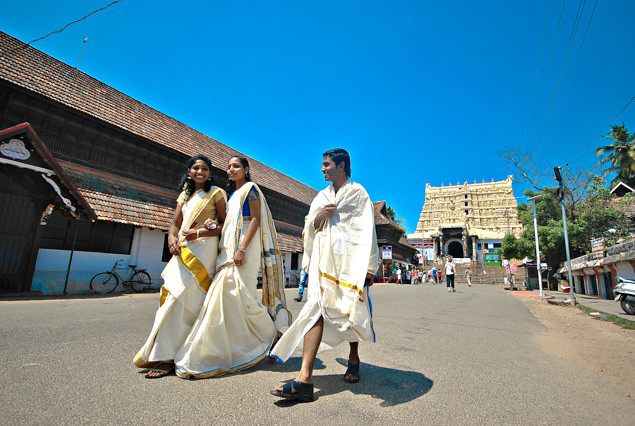
Under the unforgiving sun, we strode towards this Hindu temple crowning the entire city of Trivandrum. Its unassuming façade was gaudily painted in cream and echoes a Dravidian architectural flair – akin to most Hindu Temples I have visited before. Its soaring seven-tier quadrangular gopurams (gateway towers) – ornately designed with Hindu deities and topped with a barrel-vaulted roof with a finial – is mirrored on the placid water of a nearby lagoon. Because of its astonishing wealth the Sree Padmanabhaswamy Temple is heavily guarded by royal guards. Despite not being able to get a glimpse of its (reportedly) magnificent interior – as getting inside is off-limits to non-Hindus – knowing that I was standing in front of the richest temple in the world was enough to make me elated.
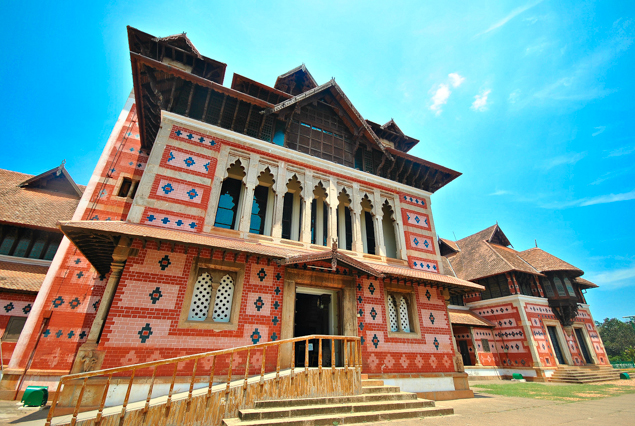
The Napier Museum architecture is a blend of Neo-Classical style and Gothic revival of Victorian Britain
Another architectural splendor in Thiruvananthapuram is Napier Museum, dating back to British colonial era. Designed by Robert Chisholm – it is ostentatiously influenced by Neo-Classical style and Gothic revival of Victorian Britain juxtaposed with Indo-Islamic and Indian structural design. This conspicuous rose-pink and red building houses exceptional historical and archaeological relic such as bronze idols, temple chariot, ivory carvings and antique ornaments, as well as Japanese shadow play leather figures used to portray the epic of Mahabharata and the Ramayana. Not to miss here is the Sree Chitra Art Gallery, opened in 1935, which exhibits fine models of Rajput, Tanjore and Mughal schools of art in India and masterpieces by Nicholas Roerich, Raja Ravi Varma and Svetlova. The collection also includes paintings from Bali, Tibet, China and Japan along with exquisite copies of ancient Indian mural paintings from as far as prehistoric period to the 18th century.
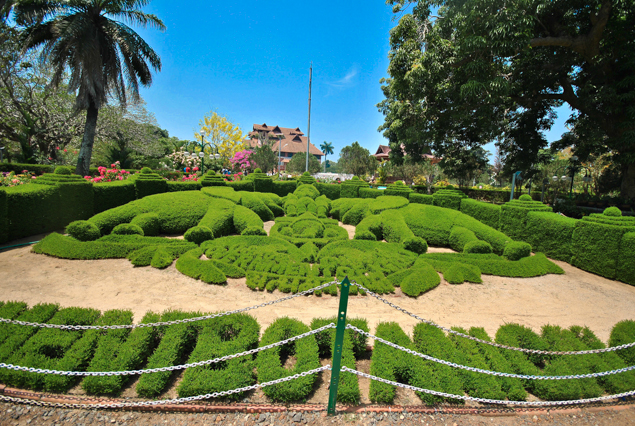
The beautifully-manicured garden at the entrance to Napier Museum
I took a leisurely walk around Napier Museum and discovered that the complex also houses a Zoological Garden – said to be one of the oldest in India having been founded sometime in 1857. Fronting the museum is an age-old bandstand fringed by a beautifully manicured garden with golden shower trees, locally known as kani konna, Kerala’s state flower.
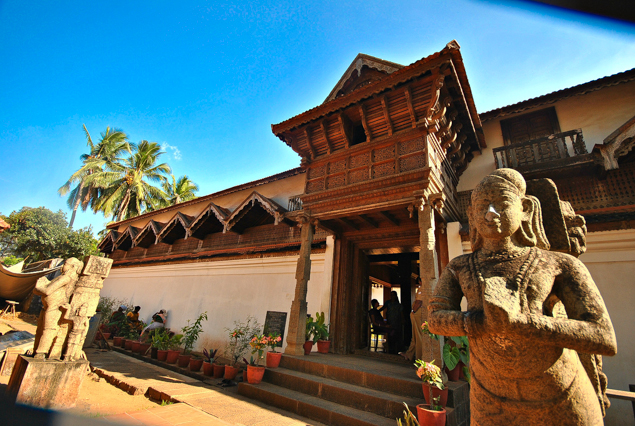
The impressive Padmanabhapuram Palace is draped by ornate carvings.
Next we drove to Padmanabhapuram Palace, about 50 kilometers away from Thiruvananthapuram. Although this handsome 16th century wooden mansion is situated in Thuckalay, on the way to Kanyamuri, in the state of Tamil Nadu – it is actually governed by Kerala. It drew elements from palatial architecture and is an impressive archetype of long-established Kerala School of Architecture. Tucked inside an ancient granite citadel, this traditional edifice hold several structures namely, Nataksala – the Performance Hall, Mantrasala – the King’s Chamber, Thai Kottaram – the Queen’s Palace, Thekee Kottaram – the Southern Palace and a four-story mansion in the midst of the complex.
A soaring clock tower with a 300 year old clock (which still keeps time) welcomed us when we entered Padmanabhapuram Palace. One of the most interesting features here is a wooden enclosure with peepholes at Nataksala, where the women of the royal family used to sit and watch shows at the dazzling black floor flanked by solid granite columns. Meanwhile, at the Queen’s Palace – the oldest structure in this stately mansion built before 1550 – there is a little room known as ekantha mandapam or the chamber of solitude, draped by ornate wood carvings. Undeniably, visiting these time-worm buildings evoke poignant memories of Trivandrum’s significant past.
This Malayali woman wearing a Mona Lisa smile is curator at Padmanabhapuram Palace. Malayalis are a Dravidian ethnic group originating from Kerala
Take me to the Beach
For a change of scenery, head to the cream to golden rugged coastline of Trivandrum. The idyllic coast of Kovalam is fringed by rocky promontories. There are three adjoining crescent-shaped well-known beaches here that summons tourists – Eve’s or Howah Beach, Ashok Beach and Lighthouse Beach (which got its name from the Vizhinjam Lighthouse standing its cliff). Howah Beach on the other hand is crowned by the Government Guesthouse and the Halycon Castle. In Kovalam, we stayed at Uday Samudra Lesiure Beach Hotel and Spa with a picturesque beachfront. Take a leisurely stroll here in the early morning to witness the local lifestyle – fishermen trawling for fish, unloading their catch and hauling their large fishing nets.
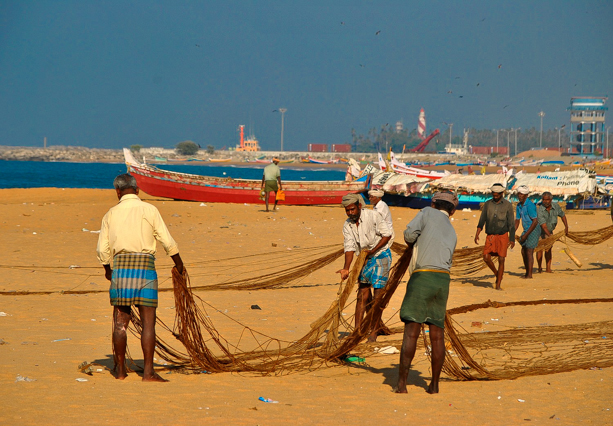
Meanwhile, the district of Varakala begins to take a wildly rugged look – fringed by red laterite cliffs jutting towards the endless sea. The famous Papanasam Beach – believed to wash away all sins – summons locals and foreign tourists alike because of its sand, sun and surf. This is the place to be if you are looking for budget hotels, guesthouses and homestays.
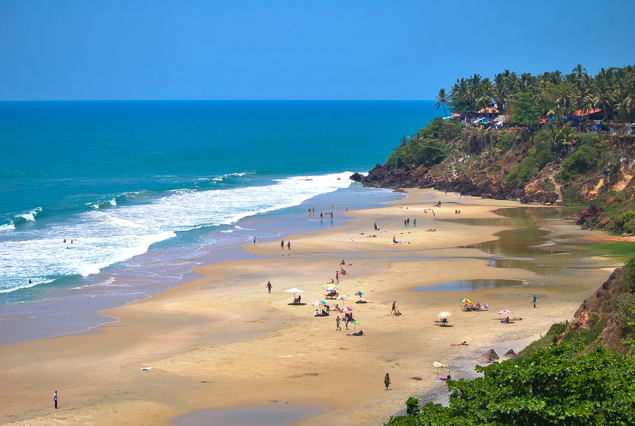
At the southernmost tip of Trivandrum lies the tiny coastal village of Poovar which looks exotic and miles away from the ordinary. In the olden days, it was a trading center of spices, sandalwood, timber and ivory where the ships or King Solomon are said to have docked. It houses one of the oldest Muslim settlements along the western shores of India. This is an ideal location if you are looking for serene beach retreat as it doesn’t see much tourist traffic. Poovar Island Resort has an Ayurveda spa village nestled in a verdant estuary. They have interesting beachfront floating villages here that are starry-eyed lover’s delight.
As I sat on the brink of a headland at The Leela Kovalam Resort with a spectacular view of Samudra Beach – the crimson twilight emerged from the horizon as if saying that Thiruvananthapuram indeed adds up to a catalogue of spectacular surprises in Southern India.

GETTING THERE:
Trivandrum International Airport (IATA: TRV) have flights to and from Manila, Philippines via Singapore. It is linked with many major cities in India by domestic flights and is well connected to other cities like Kochi (230 km), Kozhikode (420 km),Madurai (230 Km), Chennai (780 km), Bangalore(791 km), Coimbatore(400 km) by road.
WHERE TO STAY:
At the city center, check out the Mascot Hotel Trivandrum (http://www.mascothotelthiruvananthapuram.com/) or try staying at the beaches of Thiruvananthapuram.
To check the room rates and book at Mascot Hotel Trivandrum – CLICK HERE.
We stayed at Uday Samudra Leisure Beach Hotel & Spa (http://www.uds.co.in/index.php) in Kovalam along a quaint seaside village.
To check room rates and book at Uday Samudra Leisure Beach Hotel & Spa – CLICK HERE.
The Leela Kovalam (http://www.theleela.com/locations/kovalama) resting on a hill offers breath-snatching sunset views over Samudra Beach.
To check room rates and book at Leela Kovalam – CLICK HERE.
The award-winning resorts of Somatheeram (http://somatheeram.in/) and Manaltheeram (http://www.manaltheeram.com/) overlooking Chowara Beach offer indulgent Ayurveda spa.
To check room rates and book at Somatheeram Ayurveda Resort- CLICK HERE.
For updated room rates and to book at Manaltheeram Ayurveda Village – CLICK HERE
Poovar Island Resort (http://www.poovarislandresorts.com/) is where the sea, the river and the backwaters meet.
To check room rates and book at Poovar Island Resort – CLICK HERE.
If staying in Ayurveda resorts puts a large dent on your budget, then consider staying near Varkala Beach flanked by reasonably priced sleeps.
* All photos were taken using Nikon D5500 .
Nikon Philippines
Website : www.nikon.ph
Facebook : Nikon Philippines
Instagram: @officialnikonph
TRAVEL BLOG CONTENTS
FOLLOW ME ON FACEBOOK FOR TRAVEL GUIDE UPDATES

